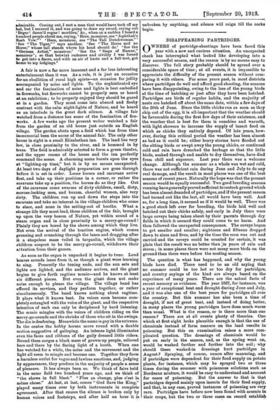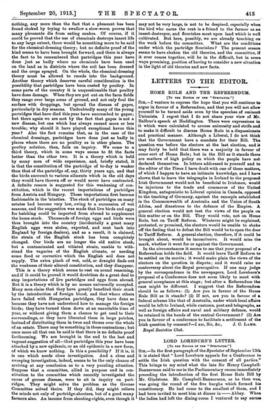DISAPPEARING PARTRIDGES.
OWNERS of partridge-shootings have been faced this year with a new and curious situation. An unexpected check has interrupted what looked like developing into a very successful season, and the reason is by no means easy to discover. The full story probably should be spread over a considerable space of time ; at all events, it is impossible to appreciate the difficulty of the present season without com- paring it with others. For some years past, in most districts where partridges do well and afford good shooting, the seasons have been disappointing, owing to the loss of the young birds at the time of hatching or just after they have been hatched. Partridges are birds of regular habits, and the majority of nests are hatched off about the same date, within a few days of the 20th of Jnne. Since the little chicks run as soon as thay chip out of the egg, it is all-important that the weather should be favourable during the first few days of their existence, and the weather that is best for them is sunshine and warmth, with light showers to increase the supply of insect food on which as chicks they entirely depend. Of late years, how- ever, during this critical period the weather has been almost as bad as it could be; either heavy storms have flooded out the sitting birds or swept away the young chicks, or continued cold and rain have drenched the herbage so that the little birds, soaked through and unable to dry themselves, have died from chill and exposure. Last year there was a welcome change. Although the summer as a whole was wet and cold, there was not sufficient rain during June and July to do any real damage, and the result in most places was one of the best seasons of recent years. Naturally the hope was that the present season would be equally successful. Two good breeding seasons running have generally proved sufficient to restock ground which has been almost denuded of partridges, and if the present season had turned out like the last, all would have been well. And so, for a long time, it seemed as if it would be well. There was a good stock left over for breeding, the birds laid well and hatched out their chicks safely, and early in July there were large coveys being taken about by their parents through dry fields in which it seemed they could come to no harm. And then followed the unexpected consequence. The coveys began to get smaller and smaller; eighteens and fifteens dropped down to sixes and fives, and by the time the corn was cut and carried and the coveys could be counted for certain, it was plain that the result was no better than in years of rain and storm; in some places there were not many more birds on the ground than there were before the nesting season.
The question is what has happened, and why the young birds have died. There used to be an old saying that no summer could be too hot or too dry for partridges, and country sayings of the kind are always based on the experience of many years. There are the actual facts of recent memory as evidence. The year 1887, for instance, was a year of exceptional heat and drought during June and July, and it was also one of the best years for partridges all over the country. But this summer has also been a time of drought, if not of great heat, and instead of doing better, in many places the young partridges have done much worse than usual. What is the reason, or is there more than one reason ? There are at all events plenty of theories. One which at first sight looks plausible enough is that the use of chemicals instead of farm manure on the land results in poisoning. But this on examination raises a more com- plicated question. The dressings of chemicals would be put on early in the season, and, as the spring went on, would be washed further and further into the soil ; why should these washed-in dressings hurt partridges in August ? Spraying, of course, comes after manuring, and if partridges were dependent for their food supply on potato plants, for instance, which may be sprayed two or three times during the summer with poisonous solutions such as Bordeaux mixture, it would be easy to understand and account for cases of poisoning. But the answer to that is that partridges depend mainly upon insects for their food supply, and that, in any case, proved instances of poisoning are very rare. Partridges have before now been found with arsenic in their crops, but the two or three cases on record establish
nothing, any more than the fact that a pheasant has been found choked by trying to swallow a slow-worm proves that many pheasants die from eating snakes. Of course, if it could be proved that the use of chemicals destroys insect life to any large extent, there would be something more to be said for the chemical-dressing theory; but no definite proof of the kind seems to have been brought forward, and there is always the fact to be remembered that partridges this year have done just as badly where no chemicals have been used on the land as in districts where the soil has been dressed and the crops sprayed. On the whole, the chemical-dressing theory must be allowed to recede into the background. Another theory which deserves careful consideration is the possibility that partridges have been ousted by poultry. In some parts of the country it is unquestionable that poultry have done damage. When they are put out on the farm fields they range over large areas of ground, and not only foul the surface with droppings, but spread the disease of gapes, particularly in dry seasons. Undoubtedly many of the young partridges that have died this year have succumbed to gapes; but there again we are met by the fact that gapes is not a new disease, but one which has always caused more or less trouble; why should it have played exceptional havoc this year ? Also the fact remains that, as in the case of the chemical dressings, partridges have done just as badly in places where there are no poultry as in other places. The poultry solution, then, fails on inquiry. We come to a tbird theory, which in some ways seems to fit the facts better than the other two. It is a theory which is held by many men of wide experience, and, briefly stated, it is that the constitution of the partridge of to-day is weaker than that of the partridge of, say, thirty years ago, and that the birds succumb to various ailments which in the old days they would have thrown off or would never have contracted. A definite reason is suggested for this weakening of con- stitution, which is the recent importations of partridges from Austria and Hungary. These importations first became fashionable in the 'nineties. The stock of partridges on many estates had become very low, owing to a succession of wet seasons, and the suggestion was made that live birds and eggs for hatching could be imported from abroad to supplement the home stock. Thousands of foreign eggs and birds were thus brought into the country (incidentally a great many English eggs were stolen, exported, and sent back into England by foreign dealers), and as a result, it is claimed, the strain of the English stock has been completely changed. Our birds are no longer the old native stock, but a contaminated and vitiated strain, unable to with- stand the vagaries of the English climate, or needing some food or corrective which the English soil does not supply. The extra pinch of wet, cold, or draught finds out the weakness of their altered constitution, and they disappear.
This is a theory which seems to rest on sound reasoning, and if it could be proved it would doubtless do a great deal to stop importations of live partridges and eggs from abroad. But it is a theory which is by no means universally accepted. Many men claim that they have greatly benefited their stock by the introduction of foreign blood, and that where others have failed with Hungarian partridges, they have done so because they have not understood how to manage the foreign birds; they have turned them down at an unsuitable time of year, or without giving them a chance to get used to their surroundings, or they have liberated them in large patches, instead of distributing them in twos and threes over the whole of an estate. There may be something in these contentions ; but once more all that can be said is that there is no definite proof forthcoming. We are brought in the end to the last and vaguest suggestion of all—that partridges this year have been attacked by a new epidemic, or an old epidemic in a new form, of which we know nothing. Is this a possibility ? If it is, it is one which needs close investigation. And a close and sweeping investigation, indeed, seems to be the only chance of arriving at any conclusion as to a very puzzling situation. Suppose that a committee, allied in purpose and in con- stitution to the committee which recently investigated the cause of grouse disease, were to sit in inquiry on part- ridges. They might solve the problem as the Grouse Committee solved theirs. If they did, they might relieve the minds not only of partridge-shooters, but of a good many farmers also. An income from shooting-rights, even though it may not be very large, is not to be despised, especially when the bird who earns the rent is a friend to the farmer as an insect-destroyer, and flourishes most upon land which is well cultivated. But here, possibly, we are already touching on the work before the committee. What are the conditions under which the partridge flourishes ? The present season seems to have shaken the old theories, and the committee, if it ever comes together, will be in the difficult, but in some ways promising, position of having to consider a new situation in the light of old theories and new facts.











































 Previous page
Previous page